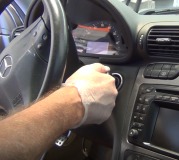At first I had a no start problem, turning the key it would just crank and crank repeatedly (fuel pump "does" bzzz/hmm, key in "on" position) without starting. I checked codes from the "CEL" (on-off-on-off-on while holding in trip/odometer)flash trick. Replaced camshaft sensor, I tested for fuel from that port on the fuel rail by pushing in on the valve (?) And gas "does" stream out. Car starts and driven three to four days(locally/to-from). Then again, no start, motor only cranks. Got "CEL codes" then replaced crankshaft position sensor, checked fuel rail and gas does stream out, turn key to on position and can hear fuel pump "bzzz/hmm, " motor cranked and started, I let it run ten minutes (?), Turned it off, thirty minutes (?) Later, motor cranks and starts, drove it about five to ten miles stopped at a gas station, filled to read half a tank of gas (was at 1/8 of tank), two hundred feet (?) From leaving the station the motor shuts off. Pulled over put it in "park, " turned key and would only crank, no start, checked over everything, "no" gas streamed out from fuel rail. Key at "on" position, you can hear the fuel pump (buzz/hmm), still no start. Spray some starting fluid, (throttle body-to-brake booster hose and into cylinder number one) the motor starts, drives two to three miles motor shuts off. I pull over put car in "park" turn key and motor cranks and starts (without using starting fluid), drive thirty seconds motor shuts off. (Did this routine three different times within ten minutes) until constant no start would only crank repeatedly with no stream from fuel rail, fuel pump does make "bzzz/hmm" sound when key is at on position. While all this cranks but no start is happening, there is no movement from the tachometer (stays at zero) while the motor is cranking. No blown fuses and all relays seem to be working (can here them click/clicking).
Sorry for the long message I just wanted to explain the details. Any suggestions on a diagnosis or on my next steps to resolve this problem would be very helpful. Car is sitting on the side of highway, two more days and it gets towed by the city.
CEL trouble codes were (11)-(12)-(37)-(42) then the obvious (55) which means scan is complete.
Before leaving the car on the highway the code (42) was read which was not reading at the beginning of the problems. (42) is dealing with the EGR?
SPONSORED LINKS
Sunday, September 2nd, 2018 AT 1:22 PM




